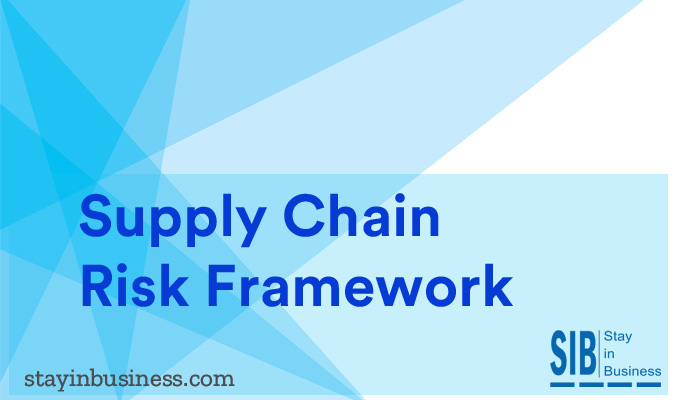
Engineering
- Knowledge
- Strategy
- Design
Collaboration
- Collective participation to develop plans
- Supply chain intelligence
Management Culture for Supply Chain Risk Framework
- Risks associated with not making informed decisions
- Being accountable and taking responsibility at the board level
- Creating business continuity teams to fortify supply chains
Agile
- Speed
- Clarity
Supply Chain Risk Framework Strategies
Input
- Business game-plan
- Value adding factors
- Supply chain operations
- Outlining the objectives of risk management
- Establishing risk appetite
- SWOT matrix
- Develop supply chains in line with risk profile
- Assess the existing supply chain network
- Cost and inventory assessment
- Find and assess alternative structures
Approaches
- One-on-one question and answer sessions
- Surveys
- Checklist
- Assumption analysis
- SWOT analysis formats
Output
- Organization’s ability to take risks
- Risk organization chart
- Job profiles and duties
- SWOT assessment
- Optimal network structure
- Identifying potential risks
- Outlining policies for dealing with risks
- Procedures for governing risks
Managing Supply Chain Risk Framework at a Tactical Level
Input
- Organization’s ability to take risks
- Risk organization chart
- Job profiles and duties
- SWOT assessment
- Optimal network structure
- Identifying potential risks
- Choosing an Optimal Network Structure
- Detecting bugs in the Supply Chain Network
- Prioritizing supply chain bugs to be fixed
- Identifying workarounds
- Outlining an alert criteria
Approaches
- Qualitative analysis
- Possibility of occurrence vs Intensity
- Collaborative problem resolution
- Visual representations of cause and effect
- Quantitative analysis
- Failure Modes and Effects Analysis (FMEA)
- Simulation
- Modeling and
- Diagramming
- Responding to risks with positive and negative impacts
- Managing opportunities and threats
- Contingency response strategies
- Risk management information systems (RMIS)
Output
- Comparative weightage for alternatives
- Risks due to contractual agreements
- Risk classification
- Comparative weightage of supply chain faults
- Centrally maintained risk repository with alert criteria
- Defining alert procedures
Managing Supply Chain Risk Framework at an Implementation Level
Input
- Strategies
- Policies
- Governing principles
- Register
- Comparative weightage for alternatives
- Risks due to contractual agreements
- Risk classification
- Comparative weightage of supply chain faults
- Risk repository with alert criteria and procedures
- Performance evaluation
- Collectively plan risk responses
- Framework for ongoing monitoring
Approaches
- Status updates and reviews
- Reevaluating risks
- Risk audits
- Deviations, assessing trends
- Using metrics to gauge performance
- Reserve analysis
- Alert mechanisms
- Repository of risk management intelligence
Output
- Risk registers
- Suggested path of action – prevention, awareness and resolution
- Tracking intrinsic, leftover and auxiliary risks
- Assess the effectiveness of the solution
Managing Iterations and Improvements for Supply Chain Risk Frameworks
Gathering Data
- Identify supply chain disruptions and how it will influence performance
Procedures
- Classify supply chain disruptions
- Collate all identified risks in a common repository
Output
- Disruption catalogue
- Risk repository
- Further examination
Information Sharing
Input
- Inform all concerned parties on the consequences of supply chain disruptions
Procedures
- Personnel in charge of the risk collate data on the disruption and spearhead all pertaining response initiatives
- Share all documented information, from initiation to resolution
Output
- Review all tasks and activities
Collaborate
Input
- Evaluate tasks and activities at hand and identify causes
Procedures
- Establish backup solutions
- Choose the most feasible alternative
- Delegate roles and responsibilities
Output
- Generate the final report after concluding the project
Enhance
Input
- Evaluate the effectiveness of the response solution after project conclusion
Procedures
- Assess the extent to which response solutions have achieved the desired targets and objectives
- Go back to the drawing board if risk mitigation strategies were not effective
- Make the necessary changes to existing solutions and update documents
Output
- Keep risk repositories up to date
Supply Chain Risk Framework Categories
- Inter-dependencies
- Affect the course of action
- Require alignment between various entities
- Foster information exchange
- Performance
- Quality
- Output
- Wherewithal
- Service
- HR
- Turnover
- Staff related problems
- Remuneration slabs
- Disruption
- Attempts to profitably raise selling price
- Information availability and accessibility
- Concentration risks
- Potential to disrupt operations
- Financial Health
- Scale
- Asset utilization
- Business model feasibility
- Profit
- Environment & Business Ecosystem
- Factors that influence supply and demand
- Mergers and acquisitions
- Compliance
- Catastrophes
- Transportation
See for yourself how the application works
Witness our cloud based platform’s security capabilities in action
Play around with the software and explore its features
Compare and choose a solution that’s relevant to your organization
Consult our experts and decide on a pricing mechanism




